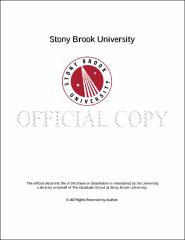| dc.identifier.uri | http://hdl.handle.net/11401/77129 | |
| dc.description.sponsorship | This work is sponsored by the Stony Brook University Graduate School in compliance with the requirements for completion of degree. | en_US |
| dc.format | Monograph | |
| dc.format.medium | Electronic Resource | en_US |
| dc.language.iso | en_US | |
| dc.publisher | The Graduate School, Stony Brook University: Stony Brook, NY. | |
| dc.type | Dissertation | |
| dcterms.abstract | Studies on the unfolded state of proteins are important for understanding the mechanism of protein folding. The protein unfolded state or protein denatured state ensemble (DSE) is the starting point for protein folding. It provides a thermodynamic reference state for protein stability, and it can be targeted by rational protein design. Studies of the properties of DSEs can also reveal the factors that impact protein misfolding and modulate the tendency for protein aggregation in vitro and in vivo, and amyloid formation. The 92-residue C-terminal domain of ribosomal protein L9 (CTL9) is used as a model to study protein DSEs. This globular protein follows a two-state folding and unfolding transition. It includes three His residues which cause it to unfold at low pH. In addition to acid-induced denaturation, CTL9 can also be unfolded by adding chemical denaturants, such as urea. A core mutant I98A-CTL9, that destabilizes the protein without perturbing the fold, is used to study protein cold denaturation and heat denaturation. The nature of temperature dependent unfolding remains controversial. The aims of the research described in my thesis are to characterize the structural and dynamic properties of CTL9 DSEs populated under various denaturing conditions, study the folding cooperativity of cold denaturation, and compare the properties of the temperature dependent I98A-CTL9 DSE to the cold unfolded DSE. Nuclear Magnetic Resonance (NMR) was used to provide residue-specific information. Small angle X-ray scattering (SAXS) was used to monitor the overall shape and compactness. The acid- and urea-induced DSE of CTL9 showed significantly different long-range contacts within the unfolded ensemble, despite the fact that they have similar radius of gyration (Rg). The properties of the DSE populated under conditions where the folded state is also present were examined as a function of pH and urea, respectively. The two-state, cooperative unfolding of cold denaturation has been examined and confirmed using the core destabilizing point mutant I98A-CTL9. The properties of the cold- and heat-induced I98A-CTL9 DSEs are compared in terms of compactness and the tendencies to form secondary structure. | |
| dcterms.available | 2017-09-20T16:52:02Z | |
| dcterms.contributor | Green, David | en_US |
| dcterms.contributor | Raleigh, Daniel P | en_US |
| dcterms.contributor | Parker, Kathlyn | en_US |
| dcterms.contributor | Bowen, Mark. | en_US |
| dcterms.creator | Luan, Bowu | |
| dcterms.dateAccepted | 2017-09-20T16:52:02Z | |
| dcterms.dateSubmitted | 2017-09-20T16:52:02Z | |
| dcterms.description | Department of Chemistry. | en_US |
| dcterms.extent | 265 pg. | en_US |
| dcterms.format | Application/PDF | en_US |
| dcterms.format | Monograph | |
| dcterms.identifier | http://hdl.handle.net/11401/77129 | |
| dcterms.issued | 2014-12-01 | |
| dcterms.language | en_US | |
| dcterms.provenance | Made available in DSpace on 2017-09-20T16:52:02Z (GMT). No. of bitstreams: 1
Luan_grad.sunysb_0771E_12140.pdf: 8437140 bytes, checksum: 71806cf32f0e80ebcef5bd97408b73a5 (MD5)
Previous issue date: 1 | en |
| dcterms.publisher | The Graduate School, Stony Brook University: Stony Brook, NY. | |
| dcterms.subject | Biochemistry | |
| dcterms.subject | denatured state ensemble (DSE), protein folding, protein unfolded state | |
| dcterms.title | The Other Half of the Protein Folding Equation Characterization of the Protein Denatured State Ensemble (DSE): The Case of C-terminal Domain of the Ribosomal Protein L9 (CTL9) | |
| dcterms.type | Dissertation | |

